|
Programme - Palaeolithic Period
UPPER PLEISTOCENE SITE DIVJE BABE I
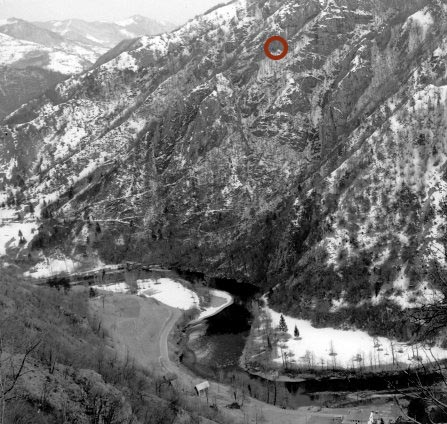 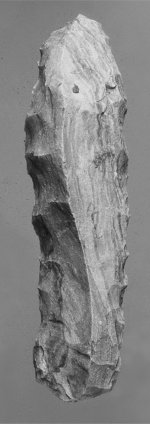
Our work focuses on the Upper Pleistocene sediments at the Divje babe I cave
site, and their content dating to the time period from the Early Glacial to the
Middle Glacial or full glacial (pleniglacial), i. e. from OIS/MIS 5 (~ 116 ka –
75 ka) to OIS/MIS 3 (~ 70 ka – 40 ka) inclusively. In our work we rely upon
sophisticated and rather original methodological approaches:
- electron spin resonance (ESR) to determine 44 calendar ages of palaeontological remains by layers
- morphogenetic and diagenetic sedimentary features to build up a detailed climatogram of the site with a time resolution of climatic events up to 700 years
- combining various data (geological, palaeontological and archaeological) into the site system, which acts as a closed entity that responds to climatic and environmetal changes
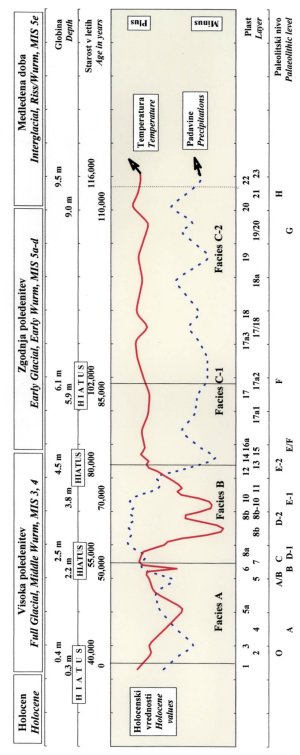
|

Topsoil congelifract (congelifracts are frost shattered, chemically rounded, rock fragments in a process of ice or frost wedging, acting exclusively in the topsoil and repeating continuously through the profile)

a) sedimentary fraction saturated with aggregates (fine particles strongly cemented into ‘clods’)
b) sedimentary fraction without aggregates, composed mainly of rock fragments.
Climatogram: The temperature is determined on the basis of the frequency of topsoil congelifracts and their Holocene value. Precipitations are determined on the basis of the frequency of topsoil aggregates and their Holocene value. The method was developed and applied for the first time at the Institute of Archaeology, Scientific Research Centre at the Slovenian Academy for Sciences and Arts. The ages in calendar years were determined using ESR at the R. F. K. Science Research Institute, New York, USA.
|
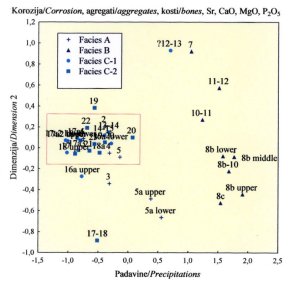 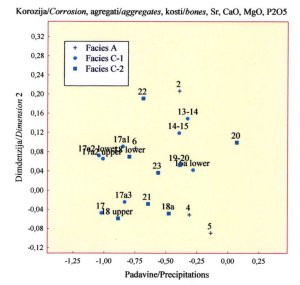
Morphological, diagenetical, palaeontological and geochemical data are all
entirely incorporated into the site system. Clusters of layers on the
abscissa, representing precipitations or humidity, and to which the analysed
data (cause-and-effect relation) are correlated, are based upon aggregates,
absolutely compatible with the precipitation curve of the
climatogram.

|
An example of how some finds of animals and plants corroborate with the
change of temperature upon congelifracts. An important result is the evidence of
mixed forest, including beech, in the vicinity of the site during the full
glacial period (OIS/MIS 3). The site distinguished itself by more than 3.000
determinations of charcoal from twenty hearths of different time periods.
|
Results of natural sciences will be presented in part one of the monography
of the site, “Divje babe I. Upper Pleistocene Palaeolithic site in Slovenia.
Part 1/1–2: Stratigraphy, sedimentology, chronology and palaeontology”. (Opera
Instituti Archaeologici Sloveniae), editor Ivan Turk. The monograph will most
probably be published in the year 2007.
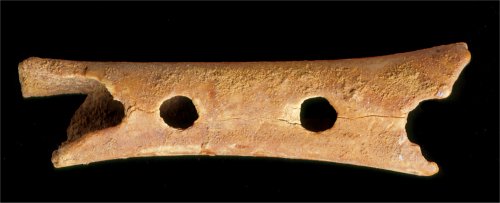
Presumably the world’s oldest flute (~ 55 ka); Mousterian, Neanderthals.
Photography: Tomaž Lauko, Narodni muzej Slovenije (Museum of Slovenia).
In connection with the climatic and environmental changes, we are now
studying all the archaeological remains, which were temporarily set on the side
-lines for the sake of the renowned ca. 55.000 years old reputed flute. The site
is outstanding, amongst others because of the very old bone and antler points in
the Mousterian Layer 20 (~ 110 ka), in Layer 10 (~ 70 ka), and in the
Aurignacian Layer 2 (~ 40 ka).
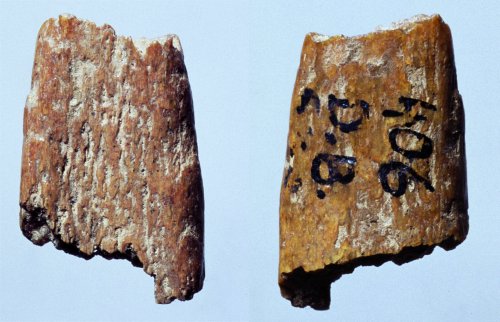
Konica v musterjenski plasti 20 (starost: pribl. 110.000 let).
Photography: Tomaž Lauko, Narodni muzej Slovenije (Museum of Slovenia).

Fragment of bone/antler point from the Mousterian Layer 20 (~ 110 ka).
Photography: Tomaž Lauko, Narodni muzej Slovenije (Museum of Slovenia).
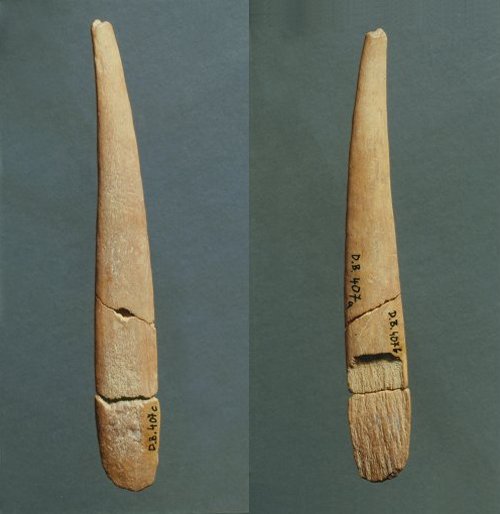
Fragment of bone point from the Mousterian Layer 10 (~ 70 ka).
Photography: Tomaž Lauko, Narodni muzej Slovenije (Museum of Slovenia).
Analyses performed on Divje babe I material are eliminating the clichés
regarding Palaeolithic archaeology, and they are changing our perceptions of
bio-cultural evolution in the region before 40 ka. These will be adequately
presented mostly in the second part of the monograph on Divje babe I under the
subtitle ‘Archaeology’. The executor of the Palaeolithic research programme and
generator of research ideas is anticipated to retire voluntarily in 2007, thus
leaving the programme and the preparation of part 2 of the monograph to the
younger generation of archaeologists. The programme priority will be the study
of unusual stone artefacts and bone/antler points from Divje babe I and the
reinterpretation of ca 130 perfectly preserved bone points from the Potočka
zijalka cave (1650 m a.s.l.) to honour the 80-year anniversary of Palaeolithic
research in Slovenia (1928–2008), which has contributed at least two world wide
important sites Potočka zijalka and Divje babe I.
Articles
- TURK, I. 2005, Zagovor morfometrične analize koščenih konic. In defence of morphometric analysis of bone points. - Arheološki vestnik 56, 453-464.
- TURK, I. 2005, Rezultati računalniške tomografije najstarejše domnevne piščali iz Divjih baba I (Slovenija): prispevek k teoriji luknjanja kosti. Results of computer tomography of the oldest suspected flute from Divje babe I (Slovenia): contribution to the theory of making holes in bones. - Arheološki vestnik 56, 9-36.
- TURK, I., D. SKABERNE, B. A. B. BLACKWELL in J. DIRJEC 2005, Ocena vlage v mlajšepleistocenskem kraškem okolju - paleoklima in paleomikrookolje v Divjih babah I, Slovenija (revizija). = Assesing humidity in the Upper Pleistocene Karst environment. Palaeoclimates and palaeomicroenvironments at Divje babe I, Slovenia. - V: A. Mihevc (ur.), Kras. Voda in življenje v kamniti pokrajini (Kras: water and life in a rocky landscape), 2005, 173-198.
- TURK, I. 2006, Prispevek Divjih bab I (Slovenija) h kronologiji mlajšega pleistocena med alpskim in dinarskim svetom. Contribution of Divje babe I (Slovenia) to the chronology of the Late Pleistocene between the Alps and the Dinarids. - Arheološki vestnik 57, 9-68.
- TURK, I., B. A. B. BLACKWELL, J. TURK in M. PFLAUM 2006., Résultats de l'analyse tomographique informatisée da la plus ancienne flûte découverte à Divje babe I (Slovénie) et sa position chronologique dans le contexte des changements paléoclimatiques et paléo-environnementaux au cours du dernier glaciaire. Results of computer tomography of the oldest suspected flute from Divje babe I (Slovenia) and its chronological position within global palaeoclimatic and palaeoenvironmental change during last Glacial. - L'Anthropologie 110, 293-317.
Contact:
dr. Ivan Turk
|
 Institute of Archaeology
Institute of Archaeology










